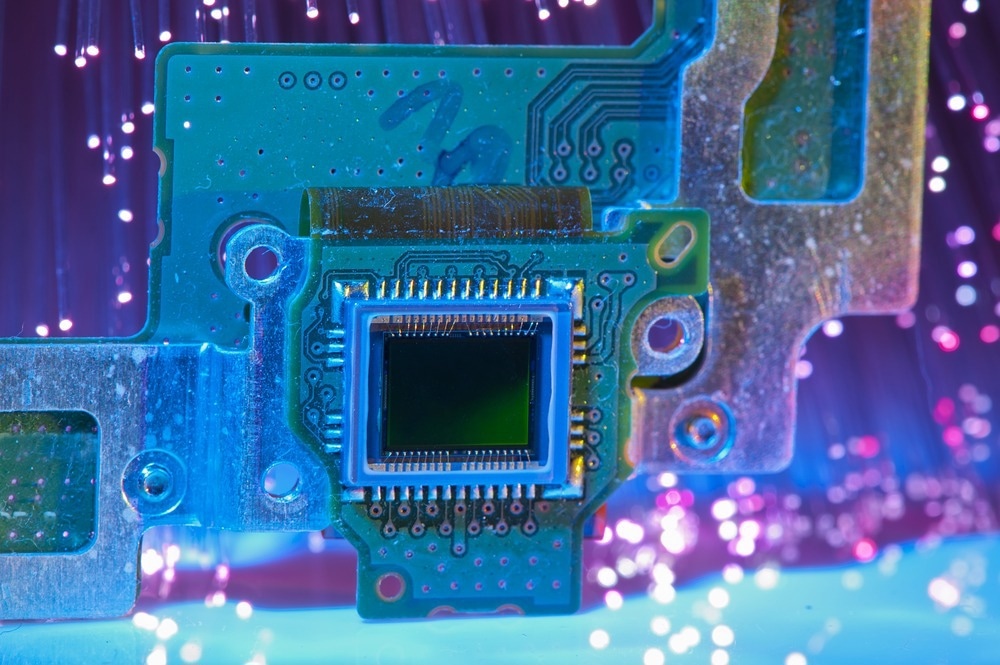Image sensors are an important technology for cameras, mobile devices with cameras inbuilt, medical imaging, and automated technology. Here, we take a deep dive into how image sensors are currently being used, where research and development are focused, what the market looks like, and how the sector may evolve into the future.
Application Areas of Image Sensors
Image sensors are an important developing technology. The most simple explanation of the technology is that it mimics the function of the human eye in that it takes light information and converts it into an electrical signal. Optical photons are captured as electrons, which are then converted via capacitors and amplifiers to a voltage, which is then processed by a computer to produce a digital image.

Image Credit: asharkyu/Shutterstock.com
There are two main types of image sensors, the charged coupled device (CCD) and the complementary metal oxide semiconductor (CMOS).
One of the biggest applications of image sensors is in cameras. In addition, image sensors have established a large footprint within the life sciences and medical market, as well as within industry. In the life sciences and medical sectors, CCD image sensors are used in several microscopes and imaging systems. Imaging sensor technology is improving medical imaging capabilities, allowing scientists to image biological samples at high levels of detail. In particular, imaging sensors are being leveraged in optical microscopy and X-Ray tomography.
Industry is also taking advantage of advancing image sensor technology to further its adoption of automated processes. Image sensor technology has enhanced the frame rate of the cameras used to automate industrial processes; therefore, it is improving the capabilities of automation in this sector. As industry 4.0 comes into full force, automation will become a key focus of industrial processes, and imaging sensors, coupled with other internet-connected sensors, will become vital to everyday processes.

Image Credit: Gorodenkoff/Shutterstock.com
Hot Topics in Image Sensors
It can be argued that the use of image sensors in medical imaging is the most keenly researched topic in image sensors.
Recent developments have been made in image sensor technology used in medical imaging applications. Currently, there is a focus on moving technology forward, overcoming the limitations of current technology to boost sensitivity and expand potential medical applications of image sensors.
A recent publication in the journal Optica describes how organic photodetectors were used in place of inorganic photodetectors to convert light signals into electric signals. While organic photodetectors have been the focus of research for a while, due to the potential they have to increase sensitivity, until this point, it has proven difficult to develop high-performance organic photodetectors.
The research showed how scientists had successfully produced novel green-light absorbing transparent organic photodetectors that were compatible with CMOS fabrication methods and able to enhance sensitivity. It is possible that these sensors will allow for an expansion of image sensors in medical science; for example, they may be leveraged in light-based heart-rate monitoring and fingerprint recognition.
Another current hot topic in image sensor research is that of applying imaging sensors to autonomous vehicles. Recently, scientists have developed silicon image sensors capable of speeding up and simplifying image processing for this emerging application. In a world first, the scientists developed an in-sensor processor integrated into silicon imaging sensors (CMOS). The innovation will further the capabilities of autonomous vehicles, as well as other commercial devices that capture visual information, such as smartphones.
Image sensors are also being researched in several other contexts, for example, in mobile devices and astronomy applications.
Current Global Market of Image Sensors
The current image sensor market is estimated to be worth around $26.1 billion in 2022. It is predicted to grow rapidly at a CAGR of 8.1% from 2022 to 2027, reaching a value of roughly $38.6 billion.
Much of this growth will be driven by the increasing demand for multiple cameras in mobile devices. There is no doubt that the widespread adoption of smartphones has boosted the image sensor market; as smartphones become more advanced, there is increasing consumer demand for higher-quality cameras built into these devices.
There is also an opportunity in this growing market presented by the increasing number of innovations in sensor technology. In the first six months of 2022, for example, the top players in the image sensor market launched 23 new products.
Asia Pacific is and will likely continue to be the most important region for the image sensor market. It currently holds the largest share of the market and is expected to grow at the highest CAGR over the forecast period. In this region, the market is driven by technological developments by major players in China, Japan, and South Korea.
Current industry key players include Sony Group (Japan), Samsung Electronics Co., Ltd. (Japan), OMNIVISION (US), STMicroelectronics N.V. (Switzerland), GalaxyCore Shanghai Limited Corporation (China), ON Semiconductor Corporation (US), Panasonic Holdings Corporation (Japan), Canon Inc. (Japan), SK hynix Inc. (South Korea), and PixArt Imaging Inc. (Taiwan).
Future Directions for Image Sensors
The image sensor market will be driven both by the demands of consumers for high-quality cameras in mobile devices, as well as the need to develop enhancing medical imaging applications. It is possible that alongside increasingly sophisticated smartphone cameras, many medical applications of image sensors will emerge on the market, such as diagnostic platforms that use images to diagnose or predict vulnerability to disease.
The sector is yet to reach its full potential; over the next decade, we will likely see many launches and advances in technology that will push the capabilities of current image sensor applications as well as expand the use of these sensors across other industries.
We can expect to see developments that enhance the sensitivity of image sensors, enabling them to produce higher-resolution images. This will be important for applications in mobile devices, medical imaging, and industrial automation.
Final Thoughts
The image sensor sector is flourishing and has great potential to be realized. While much research and development are currently focused on a few sectors, it is likely that as the technology continues to develop in the coming years.
References and Further Reading
2022. Image Sensor Market by Technology (CMOS Image Sensors), Processing Technique (2D Image Sensors, 3D Image Sensors), Spectrum, Array Type, Resolution, End-User (Consumer Electronics, Automotive) and Geography - Global Forecast to 2027 [online]. Markets and Markets. Available at: https://www.marketsandmarkets.com/Market-Reports/Image-Sensor-Semiconductor-Market-601.html
El-Desouki, M., Jamal Deen, M., Fang, Q., Liu, L., Tse, F. and Armstrong, D., 2009. CMOS Image Sensors for High Speed Applications. Sensors, 9(1), pp.430-444. https://www.mdpi.com/1424-8220/9/1/430
Jang, H., Hinton, H., Jung, WB. et al. 2022. In-sensor optoelectronic computing using electrostatically doped silicon. Nat Electron, 5, pp. 519–525. https://www.nature.com/articles/s41928-022-00819-6
Park, S., Lim, Y., Heo, C., Yun, S., Leem, D., Kim, S., Choi, B. and Park, K., 2022. Transparent organic photodiodes for high-detectivity CMOS image sensors. Optica, 9(9), p.992. https://opg.optica.org/optica/fulltext.cfm?uri=optica-9-9-992&id=495614
Sukhavasi, S., Sukhavasi, S., Elleithy, K., Abuzneid, S. and Elleithy, A., 2021. Human Body-Related Disease Diagnosis Systems Using CMOS Image Sensors: A Systematic Review. Sensors, 21(6), p.2098. https://www.mdpi.com/1424-8220/21/6/2098
Disclaimer: The views expressed here are those of the author expressed in their private capacity and do not necessarily represent the views of AZoM.com Limited T/A AZoNetwork the owner and operator of this website. This disclaimer forms part of the Terms and conditions of use of this website.